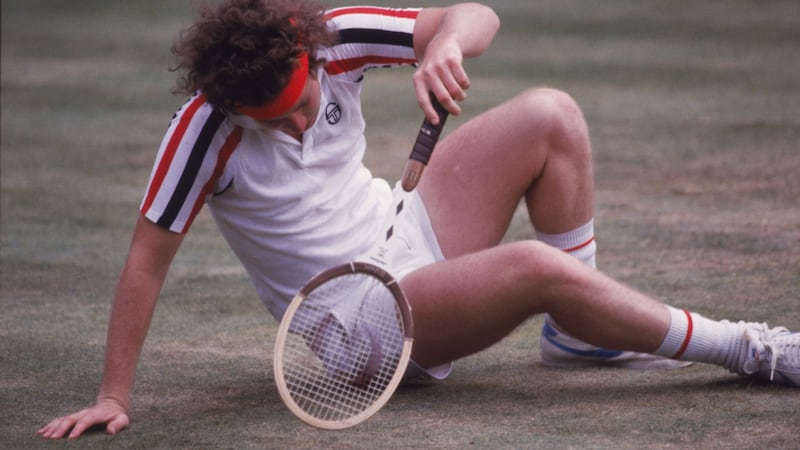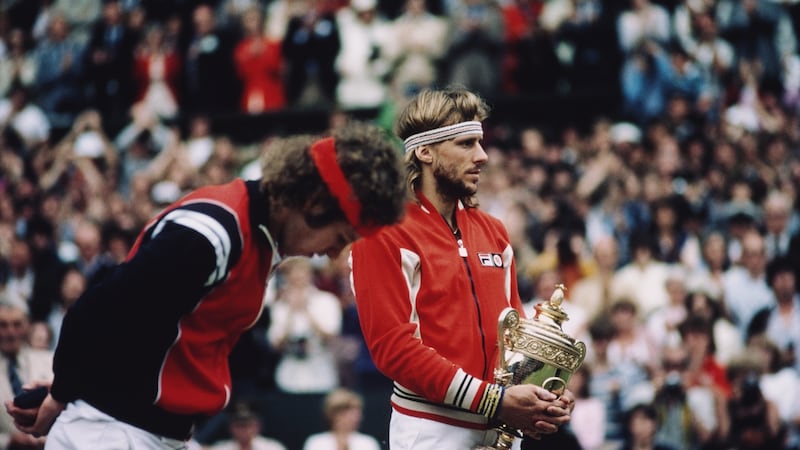An allegiance to Björn Borg in the 1980 Wimbledon men's singles final came about in circuitous fashion. He wasn't the primary object of my childhood affections when it came to tennis. That honour fell to Vitas Gerulaitis, the exotic looking, platinum haired, Rolls-Royce driving, party boy from Brooklyn, New York, whose parents hailed from Lithuania.
As a nine-year-old I knew nothing of his lifestyle, my admiration stemmed from more innocent tennis virtues, his athleticism and volleying prowess, wrapped up in an affinity for the underdog. I rooted for him in the 1977 Wimbledon singles semi-final against the defending champion, Borg. Gerulaitis had a match point en route to losing in five sets to the Swede, his great friend and practice partner.
The American would suffer defeat in all 16 singles matches between the pair including the 1980 French Open final. The same year he came out with one of the great one-liners when he managed to end another gargantuan losing sequence, this time following a Masters semi-final triumph over Jimmy Connors.
Champagne bottle in hand at the post-match press conference he smiled: "Let that be a lesson to you all, nobody beats Vitas Gerulaitis 17 times in a row." How could you not love that sense of humour? He once played in an Irish Open in Fitzwilliam as a 17-year-old and RTÉ Sport's Greg Allen, a very fine tennis player in his day, grabbed an autograph, of which I am very jealous.
Once ranked three in the world, Gerulaitis won 26 singles titles – including an Australian Open and on his retirement became a television commentator on the sport. An avid golfer he died tragically from carbon monoxide poisoning at a friend's pool-house apartment in Southampton, New York in 1994, aged, 40.
The infatuation with Gerulaitis included haranguing my parents, unsuccessfully, to buy a Snauwaert racquet bearing his name. After a brief dalliance with a Dunlop Maxply Fort, and on foot of the 1980 Wimbledon singles final, I managed to wheedle a Donnay Borg Pro, a handsome racquet; black frame, orange splashes and an elongated grip that catered admirably to the brotherhood of the double handed. I have it to this day.
Borg’s double handed backhand had a slight peculiarity because although he took the racquet back with two hands, at, or through the point of contact he often would take his left hand off and complete the stroke one-handed. He was also labelled a ‘baseliner’ but against the better players he would serve and volley on first serve and stay back on his second.
At the time in 1980, Borg, 24, had won four Wimbledon singles titles in succession, starting with his 1976 triumph against Ilie Nastase, and would face a 21-year-old prodigy in New Yorker John McEnroe, playing in his first singles final at the All England club.

McEnroe had already won a Grand Slam singles event, the 1979 US Open, beating Gerulaitis in the final, the same year in which he edged past Borg in four sets in the season ending WCT final. He won 10 singles titles that year following on from a mixed doubles win (1977) with Mary Carillo as an 18-year-old amateur at the French Open and claiming doubles titles in partnership with Peter Fleming at Wimbledon and the US Open, both in 1979.
The 1980 Wimbledon singles final was dubbed ‘Fire and Ice’ to reflect the personalities of the protagonists, the unflappable Swede against the combustible American, although if truth be told McEnroe never acted up when playing Borg, perhaps realising that his tantrums would wither on the vine.
McEnroe would always argue that his temper had to boil over for him to extract his best tennis in the heat of battle but he kept it on simmer against the Swede. Borg had no problems when confronted by petulance on the court as he had proved emphatically against Nastase and Jimmy Connors, whose occasionally stroppy antics predated McEnroe.
Borg may also have recognised a little bit of his teenage self, when in his quest for perfection racquet throwing was not an alien concept, a trait shared by a young Roger Federer; by the time both were in their pomp, those behavioural rough edges had been eradicated.
McEnroe had received an official warning from the umpire during his semi-final win over Connors and a partisan Centre Court crowd made no secret of their allegiance in the final to the point where the American was booed.
Later in life, but not that day, I would come to fully appreciate McEnroe’s artistry as a tennis player, ignoring the periodic on-court boorishness, his exquisite touch, wonderful hands, that ability to turn the power of his opponents against them, finding angles that were both obtuse and acute in guiding the ball just out of reach and that lefty serve, feet parallel to the baseline, that was so difficult to read. And truth to be told, execute, as those who tried to mimic it, fully appreciate.
BBC's voice of tennis Dan Maskell, along with John Barrett and Mark Cox, provided the soundtrack to an enthralling contest that spoke so eloquently of that era, down to the white tennis balls and the skintight shorts and shirts of the players, McEnroe sporting Sergio Tacchini; Borg, Fila. It's no wonder they had ball boys and girls.
The wooden racquets – McEnroe played with a Wilson ProStaff in that final before moving to Dunlop – with sweet spots the size of a pinhead served to underline the remarkable hand-eye coordination and ball-striking ability of the two players.

McEnroe raced through the first set, 6-1, Borg won the next two 7-5, 6-3 and at 5-4 and 40-15 in the fourth, had two championship points to earn his fifth Wimbledon title. My rising sense of excitement was ruthlessly quashed as an emboldened Borg, chipped and charged the net looking to expedite the win, only to watch helplessly as McEnroe’s array of passing shots, off both wings, rattled off four quick points, to break for 5-5.
Several minutes later at six games all, the fourth set went to a tie-break that would become one of the most celebrated in tennis history. It lasted a little over 20-minutes – nowadays it would probably take three times as long given the amount of towelling down and apparel rearranging required by the modern player – and 34 points.
Barrett, on commentary, admitted: “I don’t ever remember seeing a tie-break like this and I have seen a few good ones.” Borg had a further handful of match points but McEnroe’s nerve proved stronger and on his fifth set point, prevailed, 18-16, when his opponent snatched at a forehand volley.
I may have been close to shedding a tear, exhausted and overwhelmed by the tension and theatre, and definitely identified with Borg later describing losing that tie break as one of the worst moments of his playing career; mine watching. The fifth set was a further nerve shredding experience and at 6-6, with no break of serve or impending tie-break, looked like it could go on forever.
Except it didn’t, Borg won eight of the next nine points, his coronation coming on foot of a backhand, cross-court winner, the ball picked off his shoe laces. Celebrations were marginally different; he crumpled to the turf, I managed to overturn a couch with my sister on it.
McEnroe beat Borg the following year in the Wimbledon final ending the Swede’s 41-match singles winning streak at the All England Club. Indeed the American has a 3-1 Slam win rate against the Swede. Borg won the 1981 French Open, a sixth title to take his tally of singles Slams to 11 but within a couple of years he retired aged 26, from which he briefly emerged in the early 1990s, without success.
Having matured, slightly, I no longer align racquet with player in terms of affection which is a good thing financially – Gene Mayer (Prince), Mats Wilander (Rossignol), Stefan Edberg (Wilson ProStaff), Andre Agassi (Prince, Donnay, Head), Fabrice Santoro (Head, Inesis) and Roger Federer (Wilson) – but every time I see that Donnay Borg Pro, those warm memories of 1980 coming flooding back: Borg's win not the 'couch incident' as it was described at the time.
[ sportingmoment@irishtimes.com ]
The three overall winners will be published on Saturday, April 18th.




















